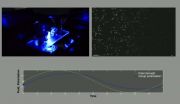(Press-News.org) June 5, 2015 - Young infants who can "resettle" themselves after waking up are more likely to sleep for prolonged periods at night, according to a video study in the June Journal of Developmental & Behavioral Pediatrics, the official journal of the Society for Developmental and Behavioral Pediatrics. The journal is published by Wolters Kluwer.
"Infants are capable of resettling themselves back to sleep by three months of age," according to the study by Ian St James-Roberts and colleagues of the University of London. They add, "Both autonomous resettling and prolonged sleeping are involved in 'sleeping through the night' at an early age."
Videos Show What Goes on When Babies 'Sleep Through the Night'
Dr. St James-Roberts and colleagues used infrared video cameras to make overnight recordings of 101 London infants. Videos made at five weeks and three months of age were analyzed to determine changes in sleep and waking during this age span--a time when parents hope their baby will start sleeping more at night, while crying less.
The researchers also looked for times when the infants woke up but were able to "resettle autonomously"--to go back to sleep without parental involvement. The video evidence was compared with parental questionnaires on their infants' sleep behaviors.
The "clearest developmental progression" between video recordings was an increase in length of sleeps: from a little over 2 hours at five weeks to 3.5 hours at three months. Only about ten percent of infants slept continuously for 5 hours or more at five weeks, compared to 45 percent at three months.
At both ages, about one-fourth of infants awoke and resettled themselves--without parental contact--at least once during the night. These infants were able to go back to sleep with little or no crying/fussing. (An online video shows a three-month-old baby waking and resettling.)
"Self-resettling at five weeks predicted prolonged sleeping at three months," the researchers write. Sixty-seven percent of infants who resettled in the first recording slept continuously for at least 5 hours in the second recording, compared to 38 percent who didn't resettle.
Infants were more likely to suck their fingers or hands at three months compared to five weeks. Infants who slept through the night at three months spent more time sucking their fingers or hands--a "self-regulatory" strategy that may help them initiate or maintain sleep.
Previous studies have suggested that breast-fed infants wake up at night because they need to feed frequently. However, the new results showed no difference in resettling or sleep times for infants fed breast milk versus formula.
Waking up and crying at night is the most common type of infant sleep problem, and one that causes exhaustion and strain for parents. Previous video studies have shown that what parents call 'sleeping through the night' is a misnomer--older babies who 'sleep through the night' not only sleep for longer periods, but also have the ability to resettle themselves after waking.
The new study confirms that some infants develop this resettling ability in the first three months of age. "Findings indicate the need for studies of how arousal, waking and resettling develop into sustained sleeping, and of how environmental factors support these endogenous and behavioral processes," Dr. St James-Roberts comments. "If they fulfill their promise, the findings may eventually help to resolve the puzzle of why so many healthy infants should be diagnosed with sleep problems, as well as helping the families involved."
INFORMATION:
Click here to read "Video Evidence That London Infants Can Resettle Themselves Back to Sleep After Waking in the Night, as well as Sleep for Long Periods, by 3 Months of Age."
Article: "Video Evidence That London Infants Can Resettle Themselves Back to Sleep After Waking in the Night, as well as Sleep for Long Periods, by 3 Months of Age" (doi: 10.1097/DBP.0000000000000166)
About the Journal of Developmental & Behavioral Pediatrics
Written for physicians, clinicians, psychologists and researchers, each bimonthly issue of the Journal of Developmental & Behavioral Pediatrics (http://www.jrnldbp.com) is devoted entirely to the developmental and psychosocial aspects of pediatric health care. Each issue brims with original articles, case reports, challenging cases and reviews--the latest work of many of today's best known leaders in related fields--that help professionals across disciplines stay current with the latest information in the field. Relevant areas covered include learning disorders, developmental disabilities, and emotional, behavioral, and psychosomatic problems. Journal of Developmental & Behavioral Pediatrics is the official journal of the Society for Developmental and Behavioral Pediatrics.
About Wolters Kluwer
Wolters Kluwer is a global leader in professional information services. Professionals in the areas of legal, business, tax, accounting, finance, audit, risk, compliance and healthcare rely on Wolters Kluwer's market leading information-enabled tools and software solutions to manage their business efficiently, deliver results to their clients, and succeed in an ever more dynamic world.
Wolters Kluwer reported 2014 annual revenues of €3.7 billion. The group serves customers in over 170 countries, and employs over 19,000 people worldwide. The company is headquartered in Alphen aan den Rijn, the Netherlands. Wolters Kluwer shares are listed on NYSE Euronext Amsterdam (WKL) and are included in the AEX and Euronext 100 indices. Wolters Kluwer has a sponsored Level 1 American Depositary Receipt program. The ADRs are traded on the over-the-counter market in the U.S. (WTKWY).
For more information about our products and organization, visit http://www.wolterskluwer.com, follow @WKHealth or @Wolters_Kluwer on Twitter, like us on Facebook, follow us on LinkedIn, or follow WoltersKluwerComms on YouTube.
Nanofibers -- polymer filaments only a couple of hundred nanometers in diameter -- have a huge range of potential applications, from solar cells to water filtration to fuel cells. But so far, their high cost of manufacture has relegated them to just a few niche industries.
In the latest issue of the journal Nanotechnology, MIT researchers describe a new technique for producing nanofibers that increases the rate of production fourfold while reducing energy consumption by more than 90 percent, holding out the prospect of cheap, efficient nanofiber production.
"We have ...
One mystery of birds' flight is solved! The elegance of birds' flight, their seemingly effortless aerial turns and the softness of their landing, have been envied by many people. From countless observations, it has been known that the birds use a small group of feathers, called "the alula", a thumb-like structure that is present at the bend of the wing, in slow and steep flight such as landing. Why do they use it? How the tiny feathers can help them land softly?
A recent article published in Scientific Reports says that the secret is a small vortex of air that is formed ...
Researchers from Uppsala University, together with colleagues at University College Dublin, have studied the dynamics of active swarms using computer simulations and experiments on unicellular algae. The team not only found full analogy of the active motion in a field to magnetic hysteresis but also managed to quantify the controllability of the swarm and identify the signatures of collective behavior of the active agents.
Active motion of living organisms and artificial self-propelling particles has been an
area of intense research at the interface of biology, chemistry ...
Dublin, June 4th 2015 - Biochemists from Trinity College Dublin have devised a new technique that will make the difficult but critical job of blueprinting certain proteins considerably faster, cheaper and easier.
The breakthrough will make a big splash in the field of drug discovery and development, where precise protein structure blueprints can help researchers understand how individual proteins work. Critically, these blueprints can show weaknesses that allow drug developers to draw up specific battle plans in the fight against diseases and infections.
Professor ...
Eye contact plays a crucial role when people initiate interaction with other people. If people look each other in the eye, they automatically send a signal that their attention is focused on the other person. If the other person happens to look back, the two will be in eye contact, and a channel for interaction is opened. Eye contact is thus a powerful social signal, which is known to increase our physiological arousal.
Previous research has suggested that eye contact triggers patterns of brain activity associated with approach motivation, whereas seeing another person ...
Extremely poor vision can be caused by strabismus in early childhood or by a displaced optical axis. Amblyopia is caused not by organic damage to the eyes but by the brain incorrectly fitting together the images the eyes provide. As a result, the ability to see an object in sharp focus is severely limited. This occurs in more than one in 20 of the German population, as Heike M. Elflein et al. show in a recent original article in Deutsches Ärzteblatt International (Dtsch Arztebl Int 2015; 112(19): 338-44). The authors' study analyzed the visual acuity of over 3200 individuals ...
As a result of their work, teachers suffer psychosomatic disorders such as exhaustion, fatigue, and headaches more frequently than other occupational groups. This has been shown by Klaus Scheuch et al. in a recent review article in Deutsches Ärzteblatt International (Dtsch Arztebl Int 2015; 112(20): 347-56), in which they analyze the health of teachers and the frequency of their illnesses.
In the study, teachers had healthier cardiovascular systems than the general population: they were more physically active (approximately 75% of teachers versus 66% of the general ...
This news release is available in Spanish. Alaitz Aizpurua, a lecturer at the UPV/EHU, maintains that "the highly widespread belief that memory deteriorates as one approaches old age is not completely true. Various pieces of neuro-psychological research and other studies show that cognitive loss starts at the age of 20 but that we hardly notice it because we have sufficient capacity to handle the needs of everyday life.This loss is more perceptible between 45 and 49 and, in general, after the age of 75, approximately."
The deterioration does not tend to be either uniform ...
A new study published in the June 15th Oceanography journal finds that effective fisheries reform strategies are more than a pipe dream: they exist and they work. In fact, rights-based fisheries management can change the lives of small-scale fishermen and coastal communities around the world.
"Solutions for recovering and sustaining the bounty of the ocean: combining fishery reforms, rights-based management and marine reserves," just published online in Oceanography shows that combining marine reserves with spatial rights-based fisheries management can provide synergistic ...
Powerful people respond quickly to unfair treatment when they are the victims, but they are less likely to notice injustice when they benefit or when others are victimized, according to new research published by the Society for Personality and Social Psychology.
In four experiments, participants who were primed to think of powerful situations perceived unfair treatment more quickly when it affected them and were more likely to take action to avoid disadvantageous situations than powerless people. The study findings didn't differ for men or women. Most of the participants ...


